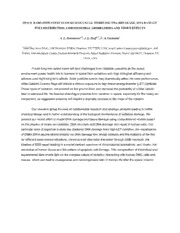
NASA Technical Reports Server (NTRS) 20110012711: Space Radiation Effects on Human Cells: Modeling DNA Breakage, DNA Damage Foci Distribution, Chromosomal Aberrations and Tissue Effects PDF
Preview NASA Technical Reports Server (NTRS) 20110012711: Space Radiation Effects on Human Cells: Modeling DNA Breakage, DNA Damage Foci Distribution, Chromosomal Aberrations and Tissue Effects
SPACE RADIATION EFFECTS ON HUMAN CELLS: MODELING DNA BREAKAGE, DNA DAMAGE FOCI DISTRIBUTION, CHROMOSOMAL ABERRATIONS AND TISSUE EFFECTS A. L. Ponomarev1,2, J. L. Huff1,2, F. A. Cucinotta2 13600 Bay Area Blvd., Life Sciences, USRA, Houston, TX 77058, USA, email: [email protected], and 2NASA Johnson Space Center, Human Research Program, Space Radiation Element, Mail Code SK37, Houston, TX 77058, USA Future long-tem space travel will face challenges from radiation concerns as the space environment poses health risk to humans in space from radiations with high biological efficiency and adverse post-flight long-term effects. Solar particles events may dramatically affect the crew performance, while Galactic Cosmic Rays will induce a chronic exposure to high-linear-energy-transfer (LET) particles. These types of radiation, not present on the ground level, can increase the probability of a fatal cancer later in astronaut life. No feasible shielding is possible from radiation in space, especially for the heavy ion component, as suggested solutions will require a dramatic increase in the mass of the mission. Our research group focuses on fundamental research and strategic analysis leading to better shielding design and to better understanding of the biological mechanisms of radiation damage. We present our recent effort to model DNA damage and tissue damage using computational models based on the physics of heavy ion radiation, DNA structure and DNA damage and repair in human cells. Our particular area of expertise include the clustered DNA damage from high-LET radiation, the visualization of DSBs (DNA double strand breaks) via DNA damage foci, image analysis and the statistics of the foci for different experimental situations, chromosomal aberration formation through DSB misrepair, the kinetics of DSB repair leading to a model-derived spectrum of chromosomal aberrations, and, finally, the simulation of human tissue and the pattern of apoptotic cell damage. This compendium of theoretical and experimental data sheds light on the complex nature of radiation interacting with human DNA, cells and tissues, which can lead to mutagenesis and carcinogenesis later in human life after the space mission.
